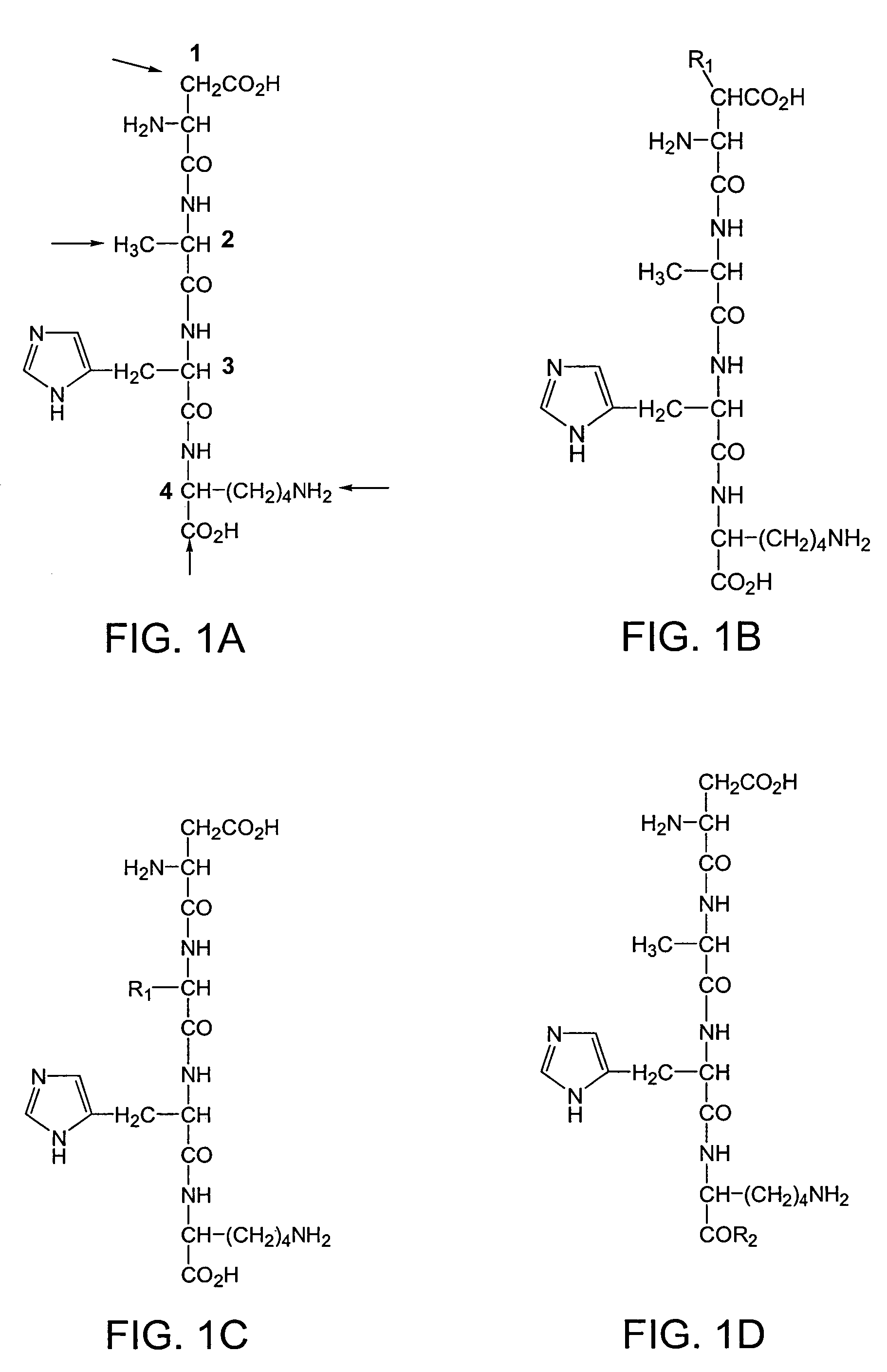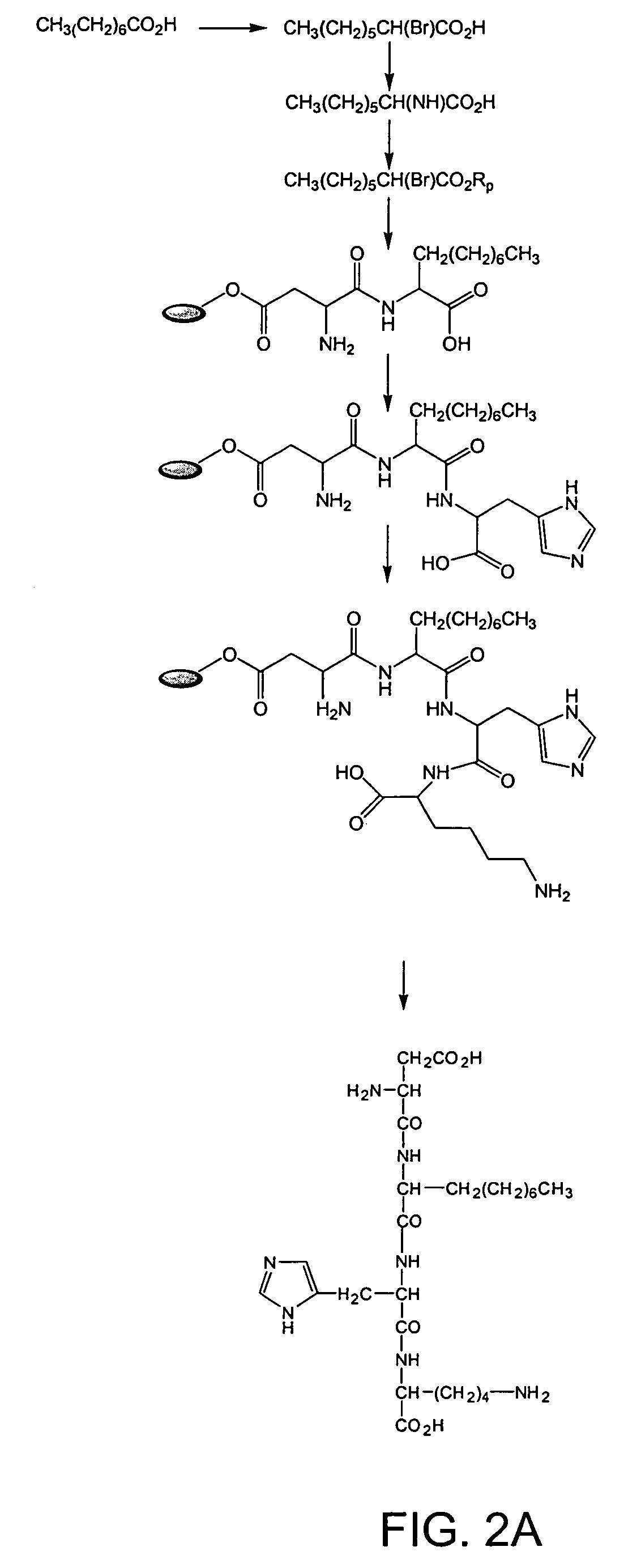Metal-binding compounds and uses therefor
a technology of metal-binding compounds and compounds, which is applied in the direction of pregnancy proteins, peptide sources, peptide/protein ingredients, etc., can solve the problems of cellular and tissue damage, reduced body's ability to provide oxygen to the heart, illness and death, etc., and achieve the effect of reducing the damage done by reactive oxygen species (ros)
- Summary
- Abstract
- Description
- Claims
- Application Information
AI Technical Summary
Benefits of technology
Problems solved by technology
Method used
Image
Examples
example 1
Synthesis of Tetrapeptide Asp Ala His Lys [SEQ ID NO:1]
[0190]This example describes the synthesis of the tetrapeptide Asp Ala His Lys [SEQ ID NO:1] composed of all L-amino acids using standard solid-phase synthesis techniques. First, 9-fluorenylmethyloxycarbonyl (Fmoc)-protected Asp (ν COO— ester; Tolsulfonyl) on Wang resin (0.6 mmole; Nova Biochem) was suspended in a solution of piperidine / dimethylformamide (DMF) (40% v / v; 3 ml) for 30 min with occasional agitation. At the end of this period, the solvent was drained, and the resin was washed sequentially with DMF and dichloromethane (DCM; 5×3 ml). A ninhydrin test was used to monitor the reaction. The resin was swollen with DMF (˜1 ml). The C-protected t-benzyloxycarbonyl (Boc) ester of alanine in DMF was added, followed by a mixture of diisopropylamine (8 equivalent) and 2-(1H-benzotriazole-1-yl)-1,2,3,3-tetramethyluroniumtetrafluoroborate (TBTU-) (4 equivalents). The resin was shaken for about 24 hours, and the reaction was monit...
example 2
Preparation of Cyclohexanediamine Derivative of Asp Ala His Lys [SEQ ID NO:1]
[0192]Trans-diaminocyclohexane was prepared by resolving cis / trans 1,2-diaminocyclohexane (Aldrich-Sigma) as the tartaric acid salt. The R-trans isomer melts at 75° C. and the S-trans isomer melts between 43-45° C. (Ph. D. Thesis, P. D. Newman, University College, Cardiff, U.K., 1994). The trans-diaminocyclohexane (10 gm) was then suspended in anhydrous toluene (30 mL) and cooled to 5° C. in an ice bath, and bromoacetic acid (8 gm) in toluene (25 mL) was added dropwise. At the end of the addition, the reaction temperature was raised to 30° C. and kept at that temperature for a further 5 hours. Toluene was evaporated, and the R-trans 1,2-diaminocyclohexane diacetic acid was crystallized from hexane / toluene to give a white solid (yield 70%). The product was characterized by spectroscopic methods.
[0193]The resin-bound tetrapeptide prepared in Example 1 (20mg) was suspended in DMF (5 mL) and was treated with th...
example 3
Preparation of Tetrapeptide Tetracetic Acid
[0194]The resin-bound tetrapeptide prepared in Example 1 (20 mg) was suspended in DMF (5 mL) and treated with excess (10-fold) chloroacetic acid. The resin was shaken at room temperature for 48 hours, followed by heating to 60° C. for a further hour. DMF was removed by filtration, and the resin was washed with DMF followed by DCM (5×3 mL). Partially dried resin was used without further treatment in the next stage. Hydrolysis of the resin linkage was effected by treating the resin-bound reaction product with TFA (5 mL; 5 hr). The resin was separated and washed with DCM. The washings were combined with TFA and concentrated under vacuum (yield 30%). The product (formula given in FIG. 4) was characterized by spectrometric methods.
PUM
| Property | Measurement | Unit |
|---|---|---|
| temperature | aaaaa | aaaaa |
| reaction temperature | aaaaa | aaaaa |
| temperature | aaaaa | aaaaa |
Abstract
Description
Claims
Application Information
 Login to View More
Login to View More - R&D
- Intellectual Property
- Life Sciences
- Materials
- Tech Scout
- Unparalleled Data Quality
- Higher Quality Content
- 60% Fewer Hallucinations
Browse by: Latest US Patents, China's latest patents, Technical Efficacy Thesaurus, Application Domain, Technology Topic, Popular Technical Reports.
© 2025 PatSnap. All rights reserved.Legal|Privacy policy|Modern Slavery Act Transparency Statement|Sitemap|About US| Contact US: help@patsnap.com



